 |
|
|
Years at Petersfield
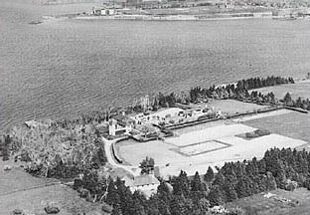 |
An aerial photo of the Petersfield estate. The vastness and
location of the estate reflected the very private lifestyle of JS McLennan.
|
|
 |
 |
|
A recent picture of Petersfield which shows a view
from the front veranda of the Petersfield estate. After its occupation by military
officers during World War II, the estate fell to ruin and was eventually torn down.
Recently, the area has been converted to a picnic park, run by the Nova Scotia Department
of Natural Resources.
|
|
| In 1899, JS developed plans for the
construction of the estate that would be known as Petersfield. The area, located on Amelia
Point across the harbour from the steel plant, was originally settled by Loyalist
immigrants from the United States. The first settlers were the family of David Matthews,
former mayor of New York, in 1785, the year of Sydney's founding. His home was completed
in 1787. The adjacent property was a land grant given to a Samuel Peters, who never
developed the site. This empty field gave the name to the general area, Petersfield.4 Early in the nineteenth century, both the Matthews and the Peters lands were
bought by an influential Cape Breton family, the Crawleys. Their estate was the most
magnificent Sydney had seen to that point. Sadly, the home was destroyed by fire in 1894.
The McLennans purchased the land down to the waterfront, and by 1901, their home was
finished.
The architectural style of the McLennan building was of the
Italianate design, popular in those times, especially among the Boston elite. The home was
beautifully proportioned and very elegant, without being pretentious. The estate was
actually two buildings, joined by a walkway and garden. The main house contained the
living areas, kitchen, bedrooms, staff quarters, library, and what the family called the
Big Room. This was a very large room that ran the length of the house. The Big Room was
undoubtedly designed for entertainment and boasted a Steinway piano and a table that sat
eighteen. The second main building was the studio, a lovely area where Louise did her
painting and where JS wrote his book. Later it would hold Katharine McLennan's model of Louisbourg. It
was used as a place to relax and get some work done, away from the bustle of the rest of
the house. It contained a skylight, an etching table, a potter's wheel, and equipment for
cutting wood blocks.5
|
|
The grounds and gardens were magnificent. Louise had a
hand in the gardens and her elegant touch was apparent. She introduced new plants and
flowers to the area, and her enjoyment of nature is obvious in the wildflower studies she
completed. Louise studied and painted various species of wildflowers in her spare time and
her sketchbook is now beautifully displayed in the Beaton Institute at the University
College of Cape Breton. Besides the gardens, the estate was graced with fine white spruce
trees that lined the drive and a massive oak tree situated in the front of the house. It
is said that the oak's branches extended to the house and formed an arch over one of the
doorways. JS would sit under this cooling arch on warm days and he referred to this as his
"Oak Tree Sitting Room". Included also on the estate was a tower, stables, the
caretaker's house, a garage, a boathouse, and grass tennis courts. The household required
the help of three servants, a cook and two housemaids. The grounds and the structure of
the buildings were tended to by the Bannister family, who acted as caretakers. James
Bannister and his wife resided in a cottage style home on the estate. The Bannister
children were reminded to stay away from the main residence, but when important visitors
would arrive, the Bannisters and their children would line the driveway in their Sunday
best. Early on, Mr. Bannister took his orders from JS, but years later, Katharine oversaw
the grounds and the buildings. However, John S. McLennan Jr. remembers Mr. Bannister
making his perfunctory call on Senator McLennan at 6:30 p.m., after cocktails, to receive
his instructions for the following day. It was this sense of tradition and faithful
respect that JS would expect and appreciate in his later years.
|
 |
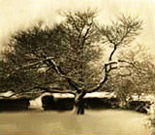 |
|
In the memories of many of the visitors to Petersfield
is the majestic beauty of the large oak tree that stood before the house. Unfortunately,
the tree was damaged after the military occupation and had to be cut down.
|
|
The furnishings at Petersfield were not formal or
pretentious. John S. Jr. described them as "elegantly comfortable". The food and
wine were always good, as was the table conversation and company. In fact, Petersfield is
most famous and historically interesting because of the guests who stayed there. Besides
frequent local visitors like Hetty Kimber and her brother Fred, Shirley Davidson, the
Burchells, the Sutherlands, the Grosvenors and visiting family members, the estate boasted
visitors of international renown. Prime Minister Robert Borden and future Prime Minister
Arthur Meighen visited Petersfield in 1911 and 1914 respectively. British Prime Minister
Ramsay MacDonald also paid a call on JS at Petersfield. Governors-General Byng,
Wellington, and Tweedsmuir all visited Petersfield. Lord and Lady Baden-Powell stayed at
Petersfield and Katharine subsequently became very involved with the Guiding movement in
Cape Breton. The poet, Sir Charles GD Roberts and the musical group the Hart House Quartet
were guests. Canadian historians DC Harvey and JC Webster, along with aeronaut FW (Casey)
Baldwin were honoured guests. Lord Grey and Admiral and Lady Kingsmill visited JS at
Petersfield. Another famous visitor was Sir Wilfred Grenfell of the Grenfell Mission of
Labrador who was a favorite of Katharine's. He inspired in her a sense of community
service, a feeling that the well-off should contribute something back to the community.
This feeling would grow during World War I and later, as she continued to work in her
community for worthy causes.
|
 |
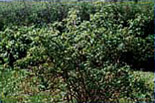 |
|
During the McLennans' stay at Petersfield, Louise
McLennan introduced many rare types of plants to the area which are not found anywhere
else in Nova Scotia. It was Louise's creative and artistic eye that made Petersfield a
landscape that was remembered for years by its visitors.
|
|
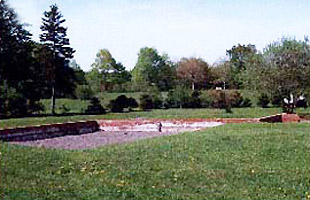 |
Shown here are the remaining foundations of the Petersfield house.
Reconstruction of the site was debated for a number of years but the cost of such a
project was too high. The site, however, is beautifully maintained as a provincial picnic
park.
|
|
 |
 |
|
A recent view of the Sydney Steel Corporation from the
Petersfield site. This plant was at one time managed by JS McLennan.
|
|
| Petersfield brought a sense of refinement and culture
of a worldly type to the area. This was a special time, an era when men and women of note,
each with their own niche and claim to fame, could mingle and be exposed to the special
interests of other learned and accomplished people. This was the environment under which
Katharine and her sisters and brother were raised. It is no wonder that they all became
accomplished in their own right. One of the more frequent
guests at Petersfield was Louise's friend Hetty Kimber. She met Hetty, much her
contemporary in age, before Petersfield was built. Hetty came originally from England and
was from a set of families referred to as the "genteel poor". To make money,
Hetty designed and painted posters, cards, and invitations for the wealthy. She followed
her brother, Fred Kimber, to Sydney in 1881 where he had a management position with one of
the collieries. The two became good friends of JS and Louise. In fact, Hetty became
Louise's painting companion and governess to Louise's children. Katharine must have
learned some of her painting technique from Hetty. It is said that Louise McLennan, Hetty
Kimber and the Brown sisters - Margaret, Elizabeth, and Lillian - were the elite group of
artists in late nineteenth century Cape Breton. The group studied Cape Breton history and
sketched and painted scenes of the area.
|
 |
 |
|
This watercolor, titled Old House at Anderson Point,
is one of Louise McLennan's works. It, along with several others, is located at the
McConnell Library, Sydney.
|
|
| The whole group connected to the McLennans and
Petersfield, and the life associated with them were of an elite and dignified nature. An
air of quiet sophistication permeated the members of the family and Petersfield functions.
The Petersfield Guest Book shows that the McLennans were host to tea parties, skating
parties, boat races, and horse-drawn sleigh rides for their friends and guests. Louise
managed the household and presided over events with a strong sense of decorum and good
taste, which Katharine would later duplicate, though on a smaller scale for the most part,
when Petersfield became more a place of repose for JS in his later years. Life at the estate was relatively quiet without guests and entertaining. One
can picture Louise in the garden or in the studio painting, JS at his desk reading and the
children going over their school studies or playing down by the waterfront. Life was very
good for the McLennans and there would be many more happy years at Petersfield for JS With
his industrial career finished, JS turned his attention to something that undoubtedly
interested him more and would eventually lead to a remarkable accomplishment, the
restoration of the Fortress of Louisbourg. Almost six decades and much work lay before the
commencement of restoration, work shared by JS and his daughter Katharine. JS still had
many other interests besides Louisbourg. This next period of JS's life shows a growing
involvement with the community and the nation at large. JS's work over the next two
decades demonstrates his commitment to serving the nation and his immense capacity for
hard work.
|
 |
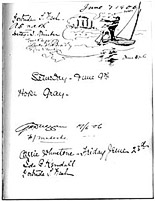 |
|
A page from the Petersfield guest book. The book is
part of the McLennan Collection located at the McConnell Library in Sydney, Nova Scotia.
|
|



